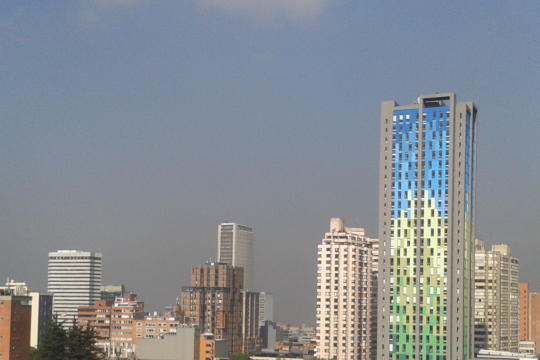Recent research shows that paving roads is the most cost-effective policy to reduce air pollution in Bogota when compared with other alternatives such as fuel substitution in industry and heavy-duty vehicle renewal. The battery of social, economic, and air quality indicators built by this research was used by the Secretary of Environment of Bogota as inputs to elaborate a public policy that is part of the proposed Plan of Territorial Management of Bogotá for the period 2022- 2035, whose purpose is to prioritize areas that require to improve air quality.
Jorge Bonilla, Claudia Aravena (EfD Colombia), and Ricardo Morales (Prof. at UniAndes) developed the Socioeconomic and Air Quality (SEAQ) index, based on the Human Development Index (HDI) or the Sustainable Development Goals Index (SDG), to analyze air quality inequality in conjunction with economic and social inequalities for more than 100 administrative zones in Bogotá, the capital of Colombia.
Air quality is inequal
The index gathers information from economic, social, and air quality variables: per capita income, land and house-building price, the relative presence of low-income families, health center supply and education services, mortality rates by all causes, and educational achievement. The study finds that air quality is highly unequal. Only 10% of the population enjoys either 15% of the best air quality or 20% of the best economic scores. Moreover, the population that is exposed to high levels of air pollution also faces low economic and social indicators. This overlap of multiple inequalities occurs in the southwest of the city.
Does not comply with international standards
Although the environmental authority of the city has conducted several strategies to reduce air pollution, Bogotá does not comply with the air quality standard guideline (AQG) defined by the World Health Organization (WHO). Before September 2021, the WHO defined fine particles as an AQG of 10 micrograms per cubic meter. Since September 2021, the AQG is 5 micrograms per cubic meter. In 2018, Bogotá showed a level of 17 micrograms per cubic meter. To address air pollution, the environmental authority has mainly focused on reducing emissions from the combustion of vehicular and industrial sources.
Road dust is a problem
In the case of public transportation, the city has made significant efforts to implement cleaner technologies for buses. However, air pollution reduction from heavy-duty vehicles has not been achieved. Moreover, recent inventories of emissions show that resuspended road dust or resuspended material is another important source of pollution. This type of particulate matter comes from a mineral source, and not from a combustion source. Resuspended material is caused by the erosion of unpaved roads, which is enhanced by winds making that dust float in the air and be easily breathed by the population.
Most cost-effective policy
With this background, researchers use the SEAQ index to assess three different policy scenarios to improve air quality: a) renewing heavy-duty vehicle fleet with Euro IV technology, b) substituting coal input with natural gas in the brick industry and other furnaces, and c) paving the unpaved roads. The authors find that the most cost-effective policy is paving roads. This strategy not only decreases air pollution but also leads to air quality improvements in areas with high levels of pollution and zones with low social and economic performance. A multidisciplinary approach was key to obtaining this conclusion because it demanded engineering knowledge to model air pollutant transport and simulate air quality effects, and economics knowledge to measure socioeconomic costs and benefits of the three policy scenarios.
Advisory member of the expert group
These results were presented at a virtual workshop last August 2021, with the participation of several stakeholders and citizens. The results were also disseminated through video and other media such as online newspapers and Television (1). Jorge Bonilla keeps constant conversation with public servants at the environmental authority and the new Secretary who started her period in 2020 with the beginning of the new city administration. As a result of the interaction between academia and policymakers, the Secretary of Environment created the Round Table of Experts to discuss critical topics of air quality in the city. Jorge Bonilla is an honorary advisory member of this group.
Actions will improve air quality
Currently, the environmental authority uses a set of economic, social, and air quality indicators to define zones that require policy intervention to improve air quality (called “urban zones for better air”(2)). The identification of those zones is part of the proposed Territorial Management Plan of the city for the period 2022 – 2035. This plan consists of actions that will improve roads, public space, and green areas, restrict high-polluting vehicles, and promote mobility alternatives, among others. Also, the results of the study served as inputs for the project “intervention plan for the southwest zone” of Bogotá, which consists of policy measures to facilitate the transition to cleaner technologies for transport and industry and to promote sustainable mobility among citizens (3).
This project was financed by the Heriot Watt University (HWU) and received an award “Highly commended” on societal engagement at HWU. This project also received congratulations for being nominated as “shortlisted” for the research team of the year 2022 in HWU.
View of air pollution in the southwest of Bogotá. Photo: Jorge Bonilla
By: Manuela Fonseca (Comm Officer) and Jorge Bonilla (EfD Director) at EfD Colombia
(1)See the video and document (in Spanish): (video by the communications office at UniAndes) https://uniandes.edu.co/es/noticias/ingenieria/la-desigualdad-de-la-calidad-del-aire-en-bogota (document) https://economia.uniandes.edu.co/publicaciones/discusiones-sobre-ambiente-para-el-desarrollo-no5
(2)“Urban zones for better air” is the English translation of ZUMA (Zonas Urbanas para un Mejor Aire). Source (in Spanish) by the Mayor’s office of Bogotá on November 26th, 2021: https://bogota.gov.co/mi-ciudad/ambiente/zuma-propuesta-del-pot-para-seguir-mejorando-la-calidad-del-aire
(3) “Intervention plan for the south-west zone” is the English translation of PISZO (Plan de Intervención de la Zona Suroccidental). Source (in Spanish) by the Mayor’s office of Bogotá on March 6th, 2022: https://bogota.gov.co/mi-ciudad/ambiente/bogota-plan-de-accion-para-el-mejoramiento-de-la-calidad-del-aire
